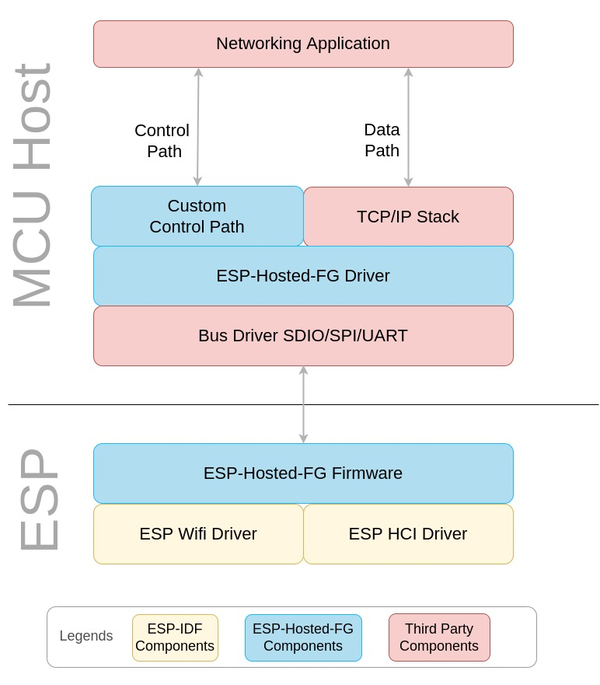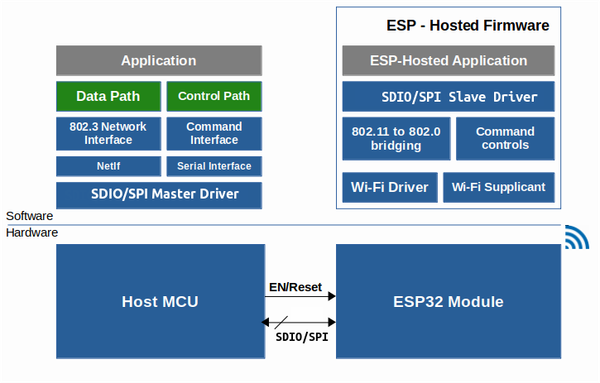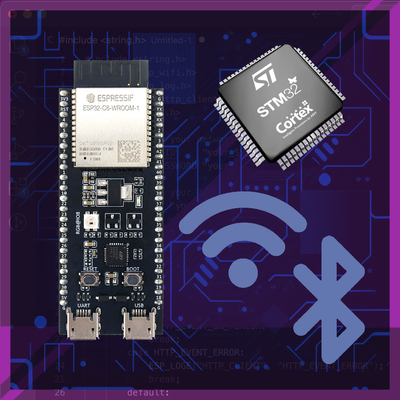
STM32 Connectivity - SMT32 WiFi and Bluetooth Capabilities with ESP32
Discover how to enhance STM32 microcontroller functionality by integrating Wi-Fi and Bluetooth capabilities using the ESP32 and ESP-Hosted Framework
In this post, we will explore how to enhance STM32 microcontrollers using the ESP32. STM32 microcontrollers are a popular choice for embedded applications, but they often lack built-in Wi-Fi connectivity. If you’ve stumbled upon this blog, you likely know that the ESP32 provides robust Wi-Fi and Bluetooth capabilities.
By utilizing the ESP-Hosted framework, you can effectively expand the functionality of STM32 devices, enabling seamless Wi-Fi communication. This integration allows you to leverage the strengths of both platforms, creating powerful and connected IoT solutions without compromising the performance of the STM32.
Supported STM32 Models for WiFi Connectivity with ESP32 (ESP-Host) #
The ESP-Hosted-FG solution is designed to support a variety of host devices out of the box, providing the capabilities of the ESP32 for seamless Wi-Fi connectivity. Among the notable STM32 MCU-based hosts that this framework accommodates are:
STM32 Discovery Board (STM32F469I-DISCO)
STM32 Discovery Board (STM32F469I-DISCO): A powerful development board featuring an STM32F469 microcontroller, ideal for multimedia applications.
Prices are subject to change. Check current prices:
STM32F412ZGT6-Nucleo 144 Board
STM32F412ZGT6-Nucleo 144: A versatile development board designed for a wide range of IoT applications, leveraging the STM32F412 microcontroller's performance.
Prices are subject to change. Check current prices:
Choosing the ESP32 - MCU Host Support #
The ESP-Hosted framework offers various transport options to facilitate connectivity between ESP chipsets and MCU-based hosts. Below is a summary of the features supported by different ESP32 chipsets across various transport interfaces:
| ESP Chipset | Transport Options | MCU Features Supported |
|---|---|---|
| ESP32 | sdio_only, sdio_uart, spi_only, spi_uart | Wi-Fi, Classic Bluetooth, BLE 4.2 |
| ESP32-C6 | spi_only, spi_uart | Wi-Fi-6, BLE 5.0 |
| ESP32-S2 | spi_only | Wi-Fi |
| ESP32-C3 | spi_only | Wi-Fi, BLE 5.0 |
| ESP32-C2 | spi_only | Wi-Fi |
| ESP32-S3 | spi_only, spi_uart | Wi-Fi, BLE 5.0 |
Note: When integrating Bluetooth functionality within MCU setups, it's important to note there are limitations. While UART support is available on the ESP slave side, it hasn't been verified for use as a host in MCU configurations.
his leaves you with the option of utilizing the ESP32 as a Bluetooth slave, provided they have a compatible Bluetooth host stack running on the MCU. This flexibility can be advantageous if you are looking to expand the wireless communication options in STM32.
Understanding ESP-Hosted #
The ESP-Hosted framework is a powerful solution designed to facilitate Wi-Fi connectivity for embedded applications by offloading Wi-Fi communication to the ESP32 chipset. This separation allows microcontrollers like STM32 to focus on core tasks while the ESP32 handles networking, enhancing overall performance and reducing development complexity.
Key Benefits: #
- Improved Efficiency: Offloading Wi-Fi communication enables better resource allocation within the MCU.
- Wi-Fi Modes: Supports both Access Point (AP) and Station (STA) modes, offering flexibility in how devices connect and communicate.
- Security Features: Implements robust security protocols, including WPA and WPA2, ensuring safe data transmission.
With these capabilities, ESP-Hosted serves as an essential tool if you are looking to integrate reliable Wi-Fi in your STM32 projects.
Transport Protocols Overview #
When working with ESP-Hosted, selecting an appropriate transport protocol is essential for effective communication between the ESP32 and the microcontroller unit (MCU). The two primary options available are SPI (Serial Peripheral Interface) and UART (Universal Asynchronous Receiver-Transmitter).
SPI (Serial Peripheral Interface):
- Known for its high-speed communication capabilities, SPI is particularly advantageous in applications that require rapid data transfer and low latency.
- It allows multiple devices to communicate over a single bus, making it a versatile choice for complex systems.
UART (Universal Asynchronous Receiver-Transmitter):
- Simpler in design compared to SPI, UART is easier to implement and often suffices for applications where speed is not the primary concern.
- Its straightforward nature makes it ideal for basic communication needs and is widely supported across various microcontroller platforms.
Considerations for Protocol Selection: #
When deciding between SPI and UART, consider the following factors:
- Data Transfer Speed: SPI is generally faster, making it suitable for bandwidth-intensive applications, while UART is more limited in speed.
- Complexity of Implementation: UART is often easier to implement, which can save time and resources during development.
- Device Compatibility: Ensure that both the ESP32 and the chosen MCU support the selected protocol to avoid compatibility issues.
ESP-Hosted-FG Architecture Overview #
The ESP-Hosted-FG architecture enables seamless integration of Wi-Fi and Bluetooth connectivity on a host device using the ESP32 as a dedicated wireless processor. Lets take a look at the system architecture design from ESP-Hosted repostitory:
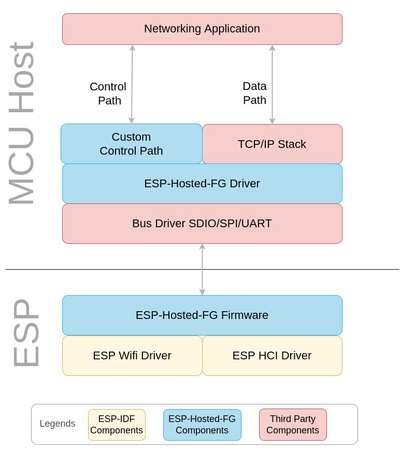
In this setup, the ESP32 offloads all Wi-Fi processing, acting as a “co-processor” for wireless communication. The host device (such as an STM32 MCU or Linux-based system) interfaces with the ESP32 through supported transport protocols, namely SPI, SDIO, and UART. This arrangement allows the host to focus on its primary tasks while the ESP32 manages networking functions.
Key Components #
The key components in the ESP-Hosted-FG system architecture are:
- ESP32 as a Wireless Co-Processor: The ESP32 handles Wi-Fi and Bluetooth processing, reducing the host’s workload.
- Transport Interfaces: Supported options include SPI, SDIO, and UART, giving flexibility based on application needs.
- Optimized Resource Use: By isolating network processing, ESP-Hosted-FG maximizes efficiency on resource-limited host devices.
This architecture makes it easy to integrate wireless capabilities into IoT devices without overloading the main processor, ensuring a stable and scalable solution.
Setting Up ESP-Hosted on STM32 Hosts #
The ESP-Hosted MCU Guide provides comprehensive instructions for setting up ESP-Hosted on an MCU-based host, such as STM32.
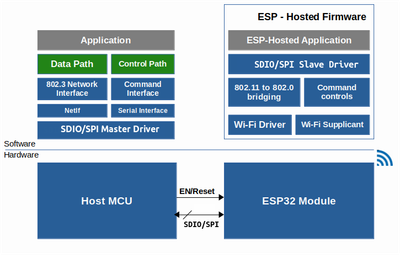
It covers initial configuration, supported transport protocols (SPI, UART), and requirements for Wi-Fi and Bluetooth functionality. The document also details the specific hardware and software setup, code integration steps, and provides troubleshooting tips to support seamless integration of Wi-Fi connectivity on MCU platforms using the ESP32.
Here’s a concise list of the tools and resources you will need for setting up ESP-Hosted on a STM32:
- STM32CubeIDE (or other compatible MCU development environments)
- ESP-IDF: Required for configuring the ESP32
- Transport Drivers: SPI or UART drivers, depending on the chosen communication protocol
- ESP-Hosted Firmware: Firmware to load onto the ESP32
- Hardware: STM32 MCU and ESP32 board, with appropriate connectors
- GPIO Configurations: Customization within IDE based on the hardware setup
Real-World Applications with STM32 WiFi #
Integrating Wi-Fi connectivity into STM32-based devices through ESP-Hosted opens up a range of possibilities across various fields. Potential use cases include:
- Industrial IoT Devices: Real-time monitoring systems for smart factories, with the ESP32 enabling wireless data collection.
- Smart Home Automation: Connectivity for devices like security cameras, smart locks, and thermostats, where STM32 handles core functions while ESP32 provides wireless communication.
- Wearable and Health Devices: Remote health monitoring solutions can leverage STM32’s processing capabilities with Wi-Fi data transmission via ESP32.
Essentially, this approach allows you to create applications typically built with an ESP32, but transferring the processing to another MCU such as STM32, allowing you to build much more powerful and versatile solutions.
Conclusion #
In summary, using the ESP-Hosted framework for Wi-Fi connectivity offers significant advantages, such as offloading network processing to the ESP32, which enhances the performance of STM32 microcontrollers. This combination allows you to create more robust and versatile applications in various domains. We hope you enjoy exploring the endless possibilities that arise when integrating STM32 and ESP32.


